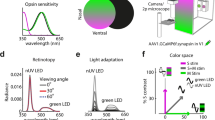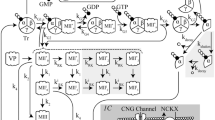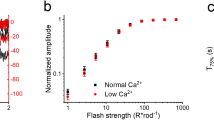Abstract
The rod pigment, rhodopsin, shows spontaneous isomerization activity. This quantal noise produces a dark light of ∼0.01 photons s−1 rod−1 in human, setting the threshold for rod vision. The spontaneous isomerization activity of human cone pigments has long remained a mystery because the effect of a single isomerized pigment molecule in cones, unlike that in rods, is small and beyond measurement. We have now overcome this problem by expressing human red cone pigment transgenically in mouse rods in order to exploit their large single-photon response, especially after genetic removal of a key negative-feedback regulation. Extrapolating the measured quantal noise of transgenic cone pigment to native human red cones, we obtained a dark rate of ∼10 false events s−1 cone−1, almost 103-fold lower than the overall dark transduction noise previously reported in primate cones. Our measurements provide a rationale for why mammalian red, green and blue cones have comparable sensitivities, unlike their amphibian counterparts.
This is a preview of subscription content, access via your institution
Access options
Subscribe to this journal
Receive 12 print issues and online access
$209.00 per year
only $17.42 per issue
Buy this article
- Purchase on Springer Link
- Instant access to full article PDF
Prices may be subject to local taxes which are calculated during checkout






Similar content being viewed by others
References
Barlow, H.B. Increment thresholds at low intensities considered as signal/noise discriminations. J. Physiol. (Lond.) 136, 469–488 (1957).
Barlow, H.B. Intrinsic noise of cones. In Visual Problems of Colour Vol. II, (ed. National Physical Laboratory, Teddington, England) 617–630 (Her Majesty's Stationery Office, London, 1958).
Donner, K. Noise and the absolute thresholds of cone and rod vision. Vision Res. 32, 853–866 (1992).
Field, G.D., Sampath, A.P. & Rieke, F. Retinal processing near absolute threshold: from behaviour to mechanism. Annu. Rev. Physiol. 67, 491–514 (2005).
Baylor, D.A., Matthews, G. & Yau, K.-W. Two components of electrical dark noise in toad rod outer segments. J. Physiol. (Lond.) 309, 591–621 (1980).
Baylor, D.A., Nunn, B.J. & Schnapf, J.L. The photocurrent, noise & spectral sensitivity of rods of the monkey Macaca fascicularis. J. Physiol. (Lond.) 357, 575–607 (1984).
Rieke, F. & Baylor, D.A. Molecular origin of continuous dark noise in rod photoreceptors. Biophys. J. 71, 2553–2572 (1996).
Lamb, T.D. & Simon, E.J. Analysis of electrical noise in turtle cones. J. Physiol. (Lond.) 272, 435–468 (1977).
Holcman, D. & Korenbrot, J.I. The limit of photoreceptor sensitivity: molecular mechanisms of dark noise in retinal cones. J. Gen. Physiol. 125, 641–660 (2005).
Schneeweis, D.M. & Schnapf, J.L. Noise and light adaptation in rods of the macaque monkey. Vis. Neurosci. 17, 659–666 (2000).
Schnapf, J.L., Nunn, B.J., Meister, M. & Baylor, D.A. Visual transduction in cones of the monkey Macaca fascicularis. J. Physiol. (Lond.) 427, 681–713 (1990).
Schneeweis, D.M. & Schnapf, J.L. The photovoltage of macaque cone photoreceptors: adaptation, noise, and kinetics. J. Neurosci. 19, 1203–1216 (1999).
Kefalov, V., Fu, Y., Marsh-Armstrong, N. & Yau, K.-W. Role of visual pigment properties in rod and cone phototransduction. Nature 425, 526–531 (2003).
Lem, J. et al. Morphological, physiological, and biochemical changes in rhodopsin knockout mice. Proc. Natl. Acad. Sci. USA 96, 736–741 (1999).
Xu, J. et al. Prolonged photoresponses in transgenic mouse rods lacking arrestin. Nature 389, 505–509 (1997).
Okada, T. et al. Circular dichroism of metaiodopsin II and its binding to transducin: a comparative study between meta II intermediates of iodopsin and rhodopsin. Biochemistry 33, 4940–4946 (1994).
Burns, M.E., Mendez, A., Chen, J. & Baylor, D.A. Dynamics of cyclic GMP synthesis in retinal rods. Neuron 36, 81–91 (2002).
Mendez, A. et al. Role of guanylate cyclase-activating proteins (GCAPS) in setting the flash sensitivity of rod photoreceptors. Proc. Natl. Acad. Sci. USA 98, 9948–9953 (2001).
Lem, J., Applebury, M.L., Falk, J.D., Flannery, J.G. & Simon, M.I. Tissue-specific and developmental regulation of rod opsin chimeric genes in transgenic mice. Neuron 6, 201–210 (1991).
Luo, D.G. & Yau, K.-W. Rod sensitivity of neonatal mouse and rat. J. Gen. Physiol. 126, 263–269 (2005).
Nakatani, K., Tamura, T. & Yau, K.-W. Light adaptation in retinal rods of the rabbit and two other nonprimate mammals. J. Gen. Physiol. 97, 413–435 (1991).
Tamura, T., Nakatani, K. & Yau, K.-W. Calcium feedback and sensitivity regulation in primate rods. J. Gen. Physiol. 98, 95–130 (1991).
Rieke, F. & Baylor, D.A. Origin and functional impact of dark noise in retinal cones. Neuron 26, 181–186 (2000).
Shi, G., Yau, K.W., Chen, J. & Kefalov, V.J. Signaling properties of a short-wave cone visual pigment and its role in phototransduction. J. Neurosci. 27, 10084–10093 (2007).
Sakurai, K. et al. Physiological properties of rod photoreceptor cells in green-sensitive cone pigment knock-in mice. J. Gen. Physiol. 130, 21–40 (2007).
Sampath, A.P. & Baylor, D.A. Molecular mechanism of spontaneous pigment activation in retinal cones. Biophys. J. 83, 184–193 (2002).
Bridges, C.D.B. Spectroscopic properties of porphyropsins. Vision Res. 7, 349–369 (1967).
Donner, K., Firsov, M.L. & Govardovskii, V.I. The frequency of isomerization-like “dark” events in rhodopsin and porphyropsin rods of the bull-frog retina. J. Physiol. (Lond.) 428, 673–692 (1990).
Ala-Laurila, P., Donner, K., Crouch, R.K. & Cornwall, M.C. Chromophore switch from 11-cis-dehydroretinal (A2) to 11-cis-retinal (A1) decreases dark noise in salamander red rods. J. Physiol. (Lond.) 585, 57–74 (2007).
Kefalov, V.J. et al. Breaking the covalent bond – a pigment property that contributes to desensitization in cones. Neuron 46, 879–890 (2005).
Dunn, F.A., Lankheet, M.J. & Rieke, F. Light adaptation in cone vision involves switching between receptor and post-receptor sites. Nature 449, 603–607 (2007).
Tachibanaki, S., Shimauchi-Matsukawa, Y., Arinobu, D. & Kawamura, S. Molecular mechanisms characterizing cone photoresponses. Photochem. Photobiol. 83, 19–26 (2007).
Nakatani, K. & Yau, K.W. Sodium-dependent calcium extrusion and sensitivity regulation in retinal cones of the salamander. J. Physiol. (Lond.) 409, 525–548 (1989).
Miller, J.L., Picones, A. & Korenbrot, J.I. Differences in transduction between rod and cone photoreceptors: an exploration of the role of calcium homeostasis. Curr. Opin. Neurobiol. 4, 488–495 (1994).
Ma, J. et al. A visual pigment expressed in both rod and cone photoreceptors. Neuron 32, 451–461 (2001).
Perry, R.J. & McNaughton, P.A. Response properties of cones from the retina of the tiger salamander. J. Physiol. (Lond.) 433, 561–587 (1991).
Wang, Y. et al. A locus control region adjacent to the human red and green visual pigment genes. Neuron 9, 429–440 (1992).
MacKenzie, D., Arendt, A., Hargrave, P., McDowell, J.H. & Molday, R.S. Localization of binding sites for carboxyl terminal specific anti-rhodopsin monoclonal antibodies using synthetic peptides. Biochemistry 23, 6544–6549 (1984).
Molday, L.L., Cook, N.J., Kaupp, U.B. & Molday, R.S. The cGMP-gated cation channel of bovine rod photoreceptor cells is associated with a 240-kDa protein exhibiting immunochemical cross-reactivity with spectrin. J. Biol. Chem. 265, 18690–18695 (1990).
Harosi, F. Absorption spectra and linear dichroism of some amphibian photoreceptors. J. Gen. Physiol. 66, 357–382 (1975).
Govardovskii, V.I., Fyhrquist, N., Reuter, T., Kuzmin, D.G. & Donner, K. In search of the visual pigment template. Vis. Neurosci. 17, 509–528 (2000).
Acknowledgements
We thank J. Lai for help in generating the transgene construct, Y. Liang, L. Ding, and Y. Wang for mouse genotyping, J. Chen (University of Southern California School of Medicine) for the Gcaps−/− and Sag−/− mice and J. Lem (Tufts University School of Medicine) for the Rho−/− mice, as well as J. Nathans (Johns Hopkins University School of Medicine) and R. Molday (University of British Columbia) for their gifts of antibodies. We are indebted to P. Ala-Laurila, D. Baylor, and J. Schnapf for discussions. This work was supported by grant EY 06837 from the US National Eye Institute to K.-W.Y.
Author information
Authors and Affiliations
Corresponding author
Supplementary information
Supplementary Text and Figures
Supplementary Figure 1, Supplementary Note (PDF 258 kb)
Rights and permissions
About this article
Cite this article
Fu, Y., Kefalov, V., Luo, DG. et al. Quantal noise from human red cone pigment. Nat Neurosci 11, 565–571 (2008). https://doi.org/10.1038/nn.2110
Received:
Accepted:
Published:
Issue Date:
DOI: https://doi.org/10.1038/nn.2110
This article is cited by
-
Investigating the Ca2+-dependent and Ca2+-independent mechanisms for mammalian cone light adaptation
Scientific Reports (2018)
-
Origin of the low thermal isomerization rate of rhodopsin chromophore
Scientific Reports (2015)
-
Origin and effect of phototransduction noise in primate cone photoreceptors
Nature Neuroscience (2013)
-
Restoration of vision after transplantation of photoreceptors
Nature (2012)
-
Cone photoreceptor contributions to noise and correlations in the retinal output
Nature Neuroscience (2011)



